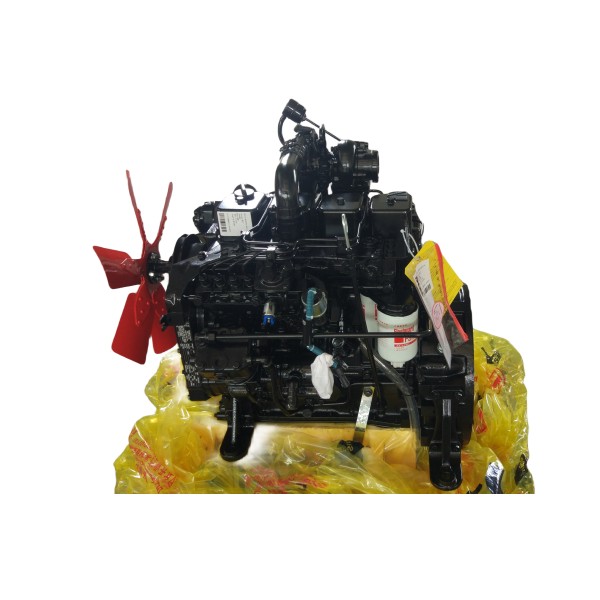The Cummins 4BT engine, a 3.9-liter inline-four diesel powerhouse, has earned its reputation as a go-to solution for demanding industrial environments. Known for its rugged simplicity, fuel efficiency, and longevity, the 4BT thrives in sectors where reliability is non-negotiable. From agriculture to construction and beyond, this engine’s ability to withstand harsh conditions makes it a cornerstone of industrial operations. In this article, we explore how the Cummins 4BT delivers durability, versatility, and cost-effective performance across industries.

1. Built to Last: Key Design Features of the Cummins 4BT
The 4BT’s legendary durability stems from its robust engineering:
- Compact Cast-Iron Block: The engine’s heavy-duty construction resists wear, even under continuous heavy loads.
- Mechanical Fuel System: Unlike modern electronically controlled engines, the 4BT’s mechanical injection pump (like the Bosch VE) minimizes electronic failures and simplifies repairs.
- Turbocharged Performance: Turbo variants (e.g., 4BTA) deliver 105–130 HP, balancing power with fuel economy.
- Low RPM Torque: Generates peak torque at 1,600–2,200 RPM, ideal for heavy machinery requiring sustained power.
2. Industrial Applications of the Cummins 4BT Engine
Agriculture and Farming Equipment
The 4BT powers tractors, irrigation pumps, and harvesters, where dust, moisture, and long operating hours are common. Its mechanical simplicity ensures minimal downtime during critical seasons.
Construction and Heavy Machinery
From skid-steer loaders to excavators, the 4BT’s compact size and torque make it a favorite for equipment requiring mobility and grunt. Its resistance to vibration and overheating suits rugged job sites.
Power Generation
As a prime mover for generators, the 4BT provides backup or primary power for factories, hospitals, and remote sites. Coupled with a generator head, it delivers stable 15–50 kW output.
Marine and Material Handling
The engine’s adaptability extends to marine propulsion and forklifts, where corrosion resistance and low-end torque are critical.
3. Why the 4BT Outperforms Competitors in Harsh Environments
- Fuel Efficiency: The 4BT consumes up to 20% less fuel than larger engines, reducing operational costs.
- Ease of Maintenance: Simple mechanics allow on-site repairs with basic tools. Common parts (e.g., gaskets, injectors) are widely available.
- Cold-Weather Reliability: Mechanical glow plugs ensure dependable starts in sub-freezing temperatures.
- Emissions Compliance: Older 4BT models (pre-Tier 4) avoid complex emissions systems, making them easier to maintain in regions with lenient regulations.
4. Maximizing the 4BT’s Lifespan in Industrial Use
Proper care ensures the engine surpasses its typical 10,000–15,000-hour service life:
- Regular Oil Changes: Use 15W-40 diesel-grade oil and replace filters every 250 hours.
- Cooling System Maintenance: Flush coolant every 2 years to prevent corrosion and overheating.
- Air Filtration: Clean or replace air filters frequently in dusty environments to avoid turbocharger damage.
- Fuel Quality: Install water separators and use biocides to combat contaminated diesel in humid climates.
5. Real-World Case Studies: The 4BT in Action
- Mining Operations: A Nevada mining company retrofitted its aging dump trucks with 4BT engines, reducing fuel costs by 18% while maintaining hauling capacity.
- Disaster Relief: NGOs deploy 4BT-powered generators in disaster zones due to their reliability and ease of repair in resource-limited settings.
- Agricultural Success: A Midwest farm reported 12+ years of trouble-free service from a 4BT-powered irrigation pump, citing minimal maintenance needs.
6. Upgrading Older Equipment with the Cummins 4BT
Many industries retrofit older machinery with the 4BT to modernize fleets without hefty investments:
- Repowering Benefits: Lower emissions, better fuel economy, and reduced downtime compared to outdated engines.
- Adaptability: Custom mounting kits and PTO options allow the 4BT to integrate into diverse equipment.
- Cost Savings: Remanufactured 4BT engines offer near-new performance at a fraction of the cost of new machinery.
7. Challenges and Considerations
While the 4BT excels in durability, be mindful of:
- Weight: At ~750 lbs, it’s heavier than some modern alternatives, affecting equipment balance.
- Noise Levels: Mechanical engines are louder; soundproofing may be needed for indoor applications.
- Parts Availability: Some OEM parts (e.g., vintage turbochargers) are discontinued, but aftermarket suppliers fill the gap.
Final Thoughts
The Cummins 4BT engine remains a stalwart in industrial applications due to its unmatched blend of strength, simplicity, and cost efficiency. Whether powering a generator in a remote location or a bulldozer on a construction site, its ability to endure extreme conditions while delivering consistent performance makes it a timeless investment. For industries prioritizing reliability over high-tech complexity, the 4BT continues to prove its worth decade after decade.